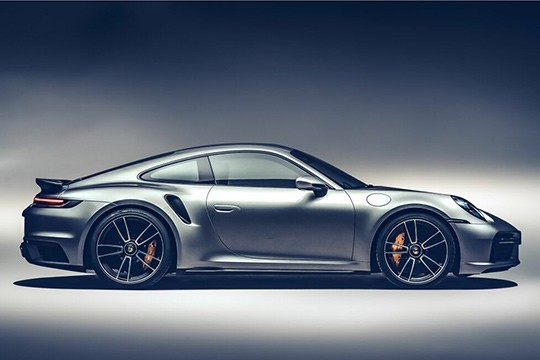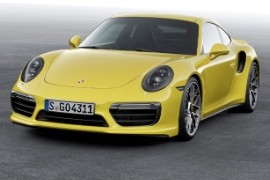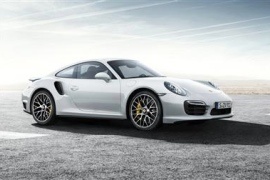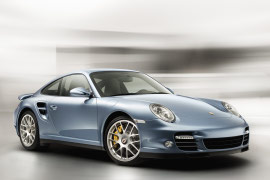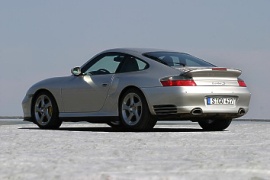PORSCHE 911 Turbo S Models/Series Timeline, Specifications & Photos
First production year: 2004
Engines: Gasoline
Body style: Coupé (two-door)
The 2020 Porsche Turbo S was heavier and bigger than its predecessor, but due to a more powerful engine and a new gearbox it was faster and it ended the battle against Tesla Model S.
The history of internal combustion engines was not over when the Porsche 911 Turbo S was introduced to the market. And it wasn't just about the power and the way it handled it. It also was about the look.
The exterior might not be as aggressive as some other Porsche models, such as the GT3 or GT2, but the new front apron was a form-follow-function concept. It featured a lip on its lower side that was extended when needed to reduce the aerodynamic lift. The three big air-intakes looked like there was a trade between the engine department and the brakes department who will get more room for cooling. The car featured 20” front wheels and 21” rear wheels. In the back, the engine lid was small, placed between the retractable wing and the rear windscreen.
Inside, the Turbo S featured a completely new dashboard. The tachometer was the only analog gauge in the instrument cluster. It was complemented on its sides by two other TFT displays. In the dashboard, at the same level as the three-spoke aluminum steering wheel, there was the screen for the PCM (Porsche Communication Management) infotainment unit. The 911 Turbo S was fitted as standard with 18-way power-adjustable seats in the front and two tiny folding seats in the back.
The engineering part of the car was the biggest improvement. It offered a newly developed, direct-injected 3.75-liter engine. It was fed by a pair of VTG turbochargers (variable turbocharged geometry) with a total result of 650 hp (70 hp more than its predecessor). It was paired to a standard 8-speed PDK (dual-clutch) automatic transmission and the result was clear: it was quicker than the Taycan Turbo S.
In 2016, the 991 generation of the Porsche 911 received a mid-life cycle refresh and it was introduced to the market. The Porsche Turbo S was enhanced as well.
Ever since 1974, the introduction of a Porsche Turbo was a hot moment for Porsche enthusiasts. The coupe version was a fierce track-contender. It was very appealing for those who were looking for a daily-driver supercar. Moreover, since the 911 Turbo S proved to be a great all-weather car, due to its all-wheel-drive system.
The facelifted version of the 991 was named 991.2. The car's front end was redesigned with side air blades and narrow LED lights, with double fillets to emphasize the car's width, as the additional fin in the main air intake. The Turbo S featured 7-spoke 20” light-alloy wheels with center lug-nut as standard. The door handles without recess covers gave the car a sleeker look. In the back, the Turbo S was easily distinguished by the four stainless steel exhaust tips in black chrome.
Inside, the new Porsche Communication Management (PCM) with navigation system was fitted as standard. The system featured a 7” touch-screen on the center stack. Unlike its predecessors, the new PCM featured Google Maps with real-time traffic information and Google StreetView. The 555 Wats Bose sound system with 12 speakers was fitted as standard, and a more sophisticated Burmester 821 watt was available on the options list.
For the engine bay, the Porsche Turbo S 991.2 offered 20 hp more than its non-facelifted version, reaching 580 hp. It was mated to a standard 7-speed automatic (dual-clutch) gearbox. To make the car faster and safer, the active roll stabilization program and the carbo-ceramic brakes were fitted as standard.
The 2013 Porsche 911 Turbo S was introduced alongside the 911 Turbo 40 years after the prototype of the 911, named 901, was unveiled at the 1963 Frankfurt Motor Show.
Since the first generation of the Turbo version, customers have asked for something more. Then, the Turbo S was introduced on the market with more power and amenities both for the interior and the technical platform.
The Turbo version was considered the 911 flagship ever since 1974 when it was introduced. Over time, quicker and faster versions of the 911 were developed. But the Turbo remained the best balance between sport and luxury. It started as a true, hard-core, sports-car, but it ended up as a better GT. The Turbo S version came to tilt the balance in favor of the sportiness. In the front, the Turbo S was distinguished by standard LED headlights and the integrated turn-signals in the daytime running light cluster.
Inside, the front Adaptive Sport Seats Plus with power 18-way adjustments were fitted as standard. They featured a memory package with electric steering column adjustments. The sport steering wheel was fitted with paddle shifters for the standard 7-speed automatic PDK (dual-clutch) gearbox. In the five-dials instrument cluster, the right one was a 4.6” high-resolution color display. The PCM (Porsche Communication Management) audio featured a twelve speaker Bose Surround System, including a 100 W active subwoofer.
The drivetrain for the Turbo S offered a 3.8-liter flat-six engine with direct fuel injection that offered 560 hp (40 hp more than the Turbo). It was aided by a pair of turbochargers with variable geometry. For better speed cornering, the car was fitted as standard with PASM (Porsche Active Suspension Management), ceramic brakes, and all-wheel steering.
For some, the Porsche Turbo was not enough so a Turbo S version was launched in 2010. While it retained most of the features of the non-S version, it added more power and torque.
Since the introduction of the Porsche Turbo in the 911 line-up, it was considered the flagship of the 911 armada. It was the best balance between performance, comfort, and luxury for a supercar. And, with the all-wheel-drive system, it was a true, four-seasons, supercar.
For the 2010 model, the Turbo S featured large air intakes and bar-shaped LED turn-signals. In the side-scoops air intakes needed to cool the front brakes, the designer incorporated the daytime running lights with LED, instead of the usual foglights. The headlights featured optional dynamic lights that improved illumination on the bends due to a swiveling mechanism. On the upper side of the rear fenders, a twin air-intake was placed to help to cool and feed the engine with fresh air.
The interior was fitted as standard with a three-spoke steering wheel and aluminum paddle-shifters behind, to manually control the gears. The sport-bucket seats were fitted as standard. For the infotainment unit, Porsche installed the PCM (Porsche Communication Management), with iOS compatibility. For Android users, the car-manufacturer offered a special application.
The Turbo S featured a new engine management system that allowed a more aggressive of the intake valves and a bigger boost for the turbochargers from 1 bar (14.5 psi) to 1.2 bars (17.4 psi). The result was an increase in power by 30 hp over the regular 2010 Porsche Turbo. The direct-injected 3.8-liter engine was mated as standard to a 7-speed PDK (double-clutch) automatic gearbox.
The 2000 Porsche Turbo was offered with an option named X50, which added more power. The 2004 Turbo S version came fitted as standard with that and added more goodies.
The 2004 Porsche Turbo S was a surprise for the market. It was the more powerful version of the 2000 911 Turbo. While it wasn't the quickest Porsche ever made, it was more performance-focused than its non-S sibling.
From the outside, the front bumper attracted views due to its large three air-intakes needed to cool the radiators like the non-S version, but a lip was added under the apron. On its sides, another pair of air-intakes needed to feed the big turbochargers were installed in front of the rear wheels. The wide rear fenders looked muscular. The rear “duck-tail” spoiler was fixed.
Inside, the Turbo S was similar to the Turbo version but included a 6-CD changer. The classic, five-dials, instrument cluster featured an aluminum background for the gauges instead of black ones. On the options list, there were new seating options.
The Turbo S was the quickest and fastest from its lineup. With a 0-100 kph (0-62 mph) under 4 seconds, it was a fierce competitor for other supercars on the market. On top of that, it featured an all-wheel-drive system, which was better in slippery conditions. The Porsche Carbon-Ceramic Brakes were fitted as standard, and the adjustable dampers offered a higher cornering speed. It was available with a 6-speed manual or a 5-speed automatic gearbox (Tiptronic) with manual override to change gears and paddle shifters.
